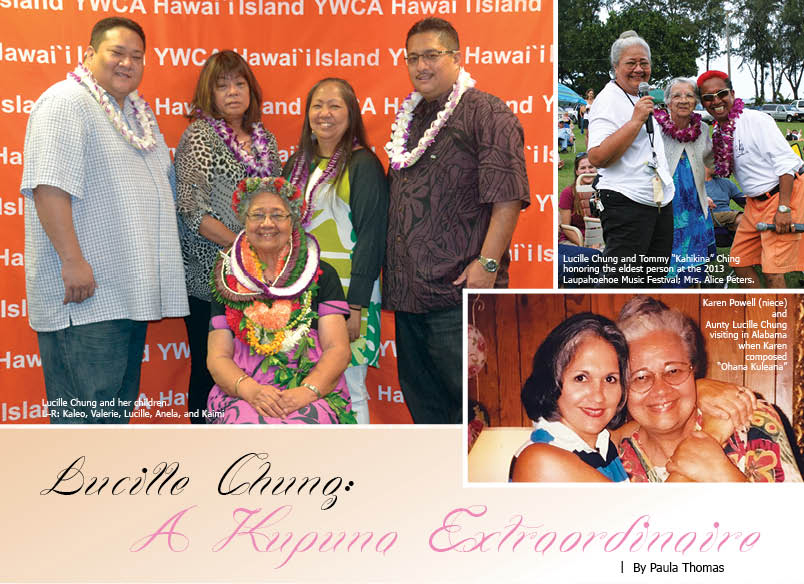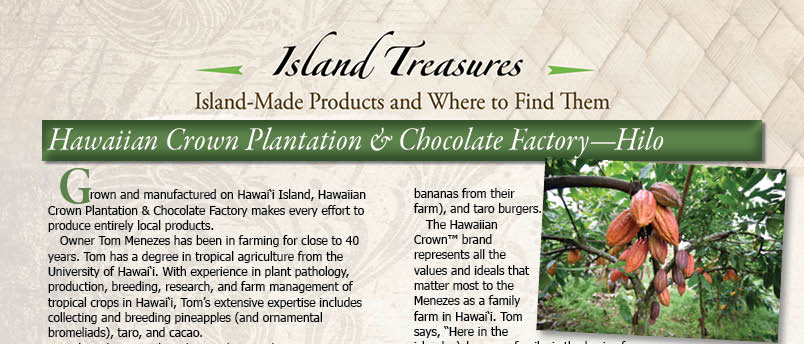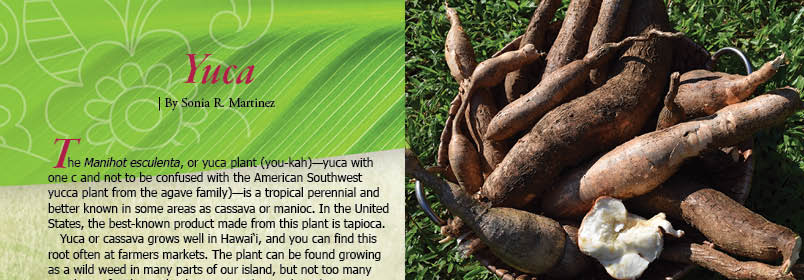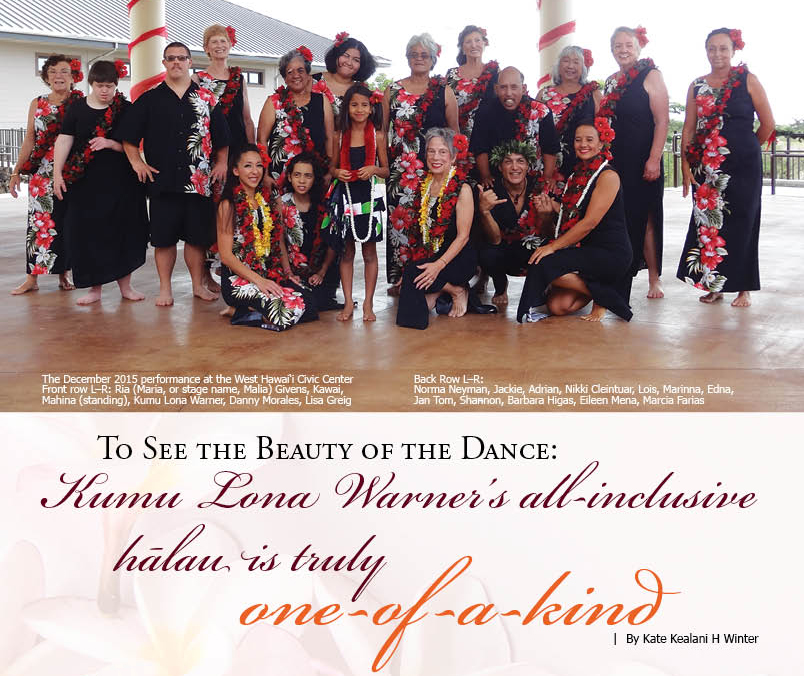
To See the Beauty of the Dance: Kumu Lona Warner’s All-Inclusive Hālau is Truly One-of-a-Kind
At the first Polynesian dance class of the new year, Kumu Lona greets each of the dancers of Hula Hālau Makanani Kona with a bright new sarong and an “Aloha” brimming with energy and affection. As the dancers arrive at the West Hawai‘i County Civic Center rotunda where they practice in the late afternoon, they greet one another with generous hugs that linger. Each dancer ties on the new pareo proudly. When everyone has assembled, the group is united by the bold colors and design of their uniform.
The haumāna (students) of this hālau (school) are a mix of young and not so young, wahine (women) and kāne (men), and in front of them waits the petite figure of their kumu Lona Warner. Wrapped in one of the same pareo, she speaks quietly to the group before the mele starts, and then they all begin to dance as she leads them—showing them, not telling them—while noting what is going on behind her in that way that great teachers can.
This is the only hālau on Hawai‘i Island—and perhaps in the state—that includes Special Olympics athletes and intellectually challenged men and women as students. For an hour they practice familiar hula and other Polynesian dances that they will perform at their public concerts with the rest of Kumu Lona’s haumāna. The dancers Lona calls “my specials” will dance with the rest of the hālau, thoroughly integrated into their summer and winter performances.
After an hour, the other dancers—kūpuna (elders) who have been quietly waiting and watching—assemble on stage to practice with the Special Olympic dancers. Later, they will divide again so that the kūpuna can have Kumu Lona’s complete attention. The breeze off the ocean dances with them in the late afternoon light. For three hours, the kumu leads the dancers through the choreography, stopping only briefly when a toddling great-grandson runs to her and reaches up. She easily lifts him, hugs him to her while they finish the dance, and then turns him loose again, hardly missing a beat.
The small woman who accomplishes all this was born in Hilo in 1940 into an ‘ohana that connected her to many of Hawai‘i’s best musicians and dancers, including the Beamers and Napua Wood, sidekick of famous entertainer, Hilo Hattie.
Lona first learned hula from her mother. Growing up, she lived in Hilo with her grandparents, Senator Eugene S. Capellas and wife, Eliza. Surrounded by a family of teachers and school principals as well as Hawaiian dancers and musicians, it may seem that she was destined to be a kumu hula, yet from childhood, she knew that she wanted to be a nurse. After graduating from St. Joseph’s private school in Hilo, she earned her nursing credentials and began her 40-year career as a nurse and teacher of nurses.
Settled in Torrance, California, she was working as a nurse, raising daughters and stepdaughters, and volunteering with various community service projects like Girl Scouts (where she became a troop leader) and Special Olympics. She made frequent trips home to Hawai‘i Island in those years, going back to the source. In 1976, her love of hula asserted itself, and she formed her own hālau in her home in Torrance. The group grew quickly and moved out of the house and into a community center.
Lona danced her way through 30 years of living in Torrance before she retired from nursing and returned home to Hawai‘i Island, Kona side, leaving her California hālau to her daughter.
Back in Hawai‘i in 2003, she soon recognized the need for a place for kūpuna to dance hula as well as other Polynesian styles and started Hula Hālau Makanani Kona.
There are two guiding principles for Kumu Lona’s Kona hālau: being non-competitive and being inclusive. Competition creates stress, something she tries to keep out of her hālau. There is something sacred in hula’s movement to music, and when dance is shared by a group of people committed to the art of hula and their hālau brothers and sisters, it is full of grace. They are not dancing for others, but with others.
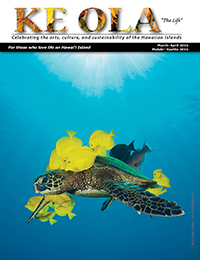
Kumu Lona says, “Hula is a sacred living art form that thrives because it is continually being shared, passed on from one person to the next. It is the language of aloha, and it belongs to all of Hawai‘i’s people. We should not exclude those who seriously want to learn simply because they might take a little longer to become skilled or because we think they may never attain certain levels of perfection.”
She believes that dance should be open to anyone who loves hula and is willing to do what is necessary to learn. Her teaching has provided a place for that learning and more, a space open to people who otherwise would be marginalized or limited to being in the audience.
Instead, kūpuna, wahine and kāne, middle-aged folks who never danced hula until Lona invited them in, and Special Olympic athletes have all become more than anyone else saw them being. The other dancers get to know the special needs dancers as individuals and hula peers, enriching their own lives.
As a teacher, Lona has patience and compassion for all the dancers in the hālau and never singles out an individual for correction in front of the others, instead telling the whole group what needs to be changed or improved. Even the name of the hālau speaks of her wide and deep aloha: maka (to see) and nani (beauty). Lona sees the beauty in everyone.
Having been a long-time Special Olympics volunteer since her days in California, Lona joined in the West Hawai‘i area program when she came home. She became a coach—another kind of kumu—for bocce, t-ball, and bowling and was recognized in 2007 and 2009 as Outstanding Coach and in 2008 as Outstanding Ambassador for Special Olympics. After becoming the Head of Delegation, she was honored with the Lifetime Achievement Award at the state level.
At one point, the parents of some Special Olympic athletes asked if she could teach their sons to dance since the boys had expressed an interest. With her signature enthusiasm, she answered yes, reflecting now that “I had always wanted to add a kāne class to my hālau, and this seemed like the perfect way to begin.” In 2007, she began with four kāne special athletes and three other male dancers without disabilities.
And how they dance! In concert and in practice, they are fully engaged in the dance, proud, and joyful. Their accomplished performance inspires the other dancers, and when the whole hālau dances together, the deep aloha is palpable. Their kumu says, “We do this simply because we love it, and in performing, we get to share our aloha with our families, our friends, and
the community.”
You will not find this hālau competing at Merrie Monarch or any hula contests, however you can see them entertaining at the Kings’ Shops, Waikoloa (the second Friday of the month, 6-7 pm), at Hualālai Regency twice a year, at two annual Saturday concerts at the West Hawai‘i Civic Center, and at community events and festivals of all kinds. Merchants always appreciate the foot traffic and patronage that follows wherever the hālau performs. The hālau website lists upcoming performances and includes videos of the group—a sincere gesture of sharing that expresses Kumu Lona’s generosity. She also includes lyrics, translations, and choreography for her haumāna, a very modern use of technology for a very old art form.
Don’t expect a watered-down style of traditional dance. The varieties that can be seen at any Polynesian show are included—Maori, Tahitian, and Hawaiian kahiko (ancient), ‘auana (modern), and even noho (sitting) that accommodates wheelchair bound dancers while challenging the others—as well as the familiar hula implements: poi balls, pū‘ili, and ipu.
At the close of a performance, Hālau Makanani usually dances their signature piece, Melveen Leed’s beautiful mele pule (prayer song), “Walk Through Paradise/Kanaka Waiwai.” It is a fitting close to an inspiring experience of aloha and hula.
Meeting Lona is like being touched by a hummingbird. She is dazzling and lovely in her brightness, small and full of energy. She is always whizzing around the Kona community from one service project to another. She can be found working at the Ironman® Triathlon and the Kona Marathon as well as the Queen Lili‘uokalani canoe races.
As Head of Delegation for West Hawai‘i Special Olympics, she has been responsible for all their sports events from Ka‘ū to Waimea.
One day each week, she gives free hula lessons at Hualālai Elderly Housing in Kailua-Kona, spreading aloha to another of Kona’s under-served populations. And though she buzzes from one event to another, she seems completely present in all she does.
One of her students likens her to a lighthouse—like the ones Lona herself collects—always giving off light and leading people home. That was one of the many reasons she got public recognition and was nominated for the Hawai‘i County Outstanding Older American Award in 2010. Even now, she moves like a dancer, still lithe and athletic, her graceful arms and hands telling the stories of aloha.
Now she insists that she has just retired from heading up the Special Olympics, but is always ready on the sidelines to train new coaches and leaders, remaining a lifelong volunteer.
One of her most passionate hopes is that “all hālau in Hawai‘i will include physically and mentally challenged people in hula.” She is continually finding ways to help others grow, learn, and discover their own potential. The difference that her teaching makes for all her haumāna, including her “specials” is as parents and students will tell you, more self-confidence, better social skills, fitness, and independence.
One mother says that her daughter has learned to listen, to be quiet, and not be in charge.
The mother of another special dancer thanks Lona for giving her and her child the opportunity to dance together.
One dancer says, “Lona has given me a gift that has changed my life.”
Her energy feels boundless to many of the people whose lives she touches. Lona laughs and waves her beautifully expressive hands when asked where she gets her admirable sustained energy. She says it may be the two glasses of champagne she drinks with dinner almost every night. Perhaps. After all, hummingbirds drink nectar.
Whatever the source, Lona’s gift of aloha is spread lovingly throughout the Kona community. ❖
December 2015 performance photos by Renée Robinson
Historic photos courtesy Lona Warner.
Contact Lona Warner: 808.327.0491
Contact writer Kate Kealani H Winter

